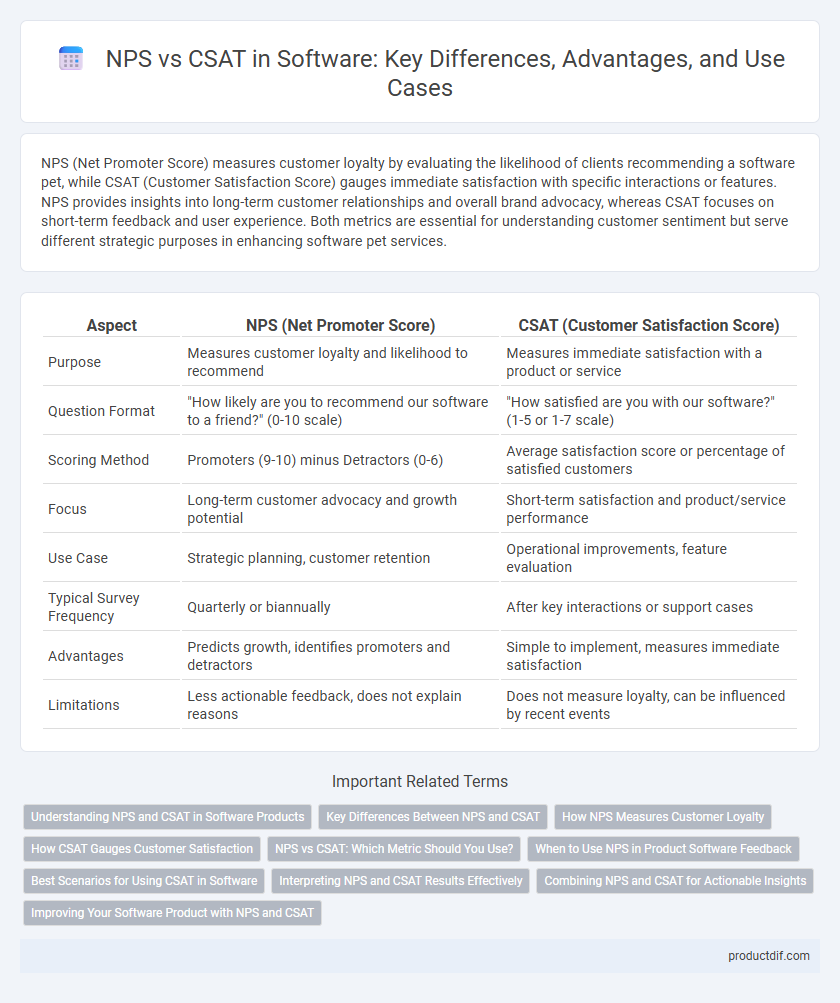NPS (Net Promoter Score) measures customer loyalty by evaluating the likelihood of clients recommending a software pet, while CSAT (Customer Satisfaction Score) gauges immediate satisfaction with specific interactions or features. NPS provides insights into long-term customer relationships and overall brand advocacy, whereas CSAT focuses on short-term feedback and user experience. Both metrics are essential for understanding customer sentiment but serve different strategic purposes in enhancing software pet services.
Table of Comparison
| Aspect | NPS (Net Promoter Score) | CSAT (Customer Satisfaction Score) |
|---|---|---|
| Purpose | Measures customer loyalty and likelihood to recommend | Measures immediate satisfaction with a product or service |
| Question Format | "How likely are you to recommend our software to a friend?" (0-10 scale) | "How satisfied are you with our software?" (1-5 or 1-7 scale) |
| Scoring Method | Promoters (9-10) minus Detractors (0-6) | Average satisfaction score or percentage of satisfied customers |
| Focus | Long-term customer advocacy and growth potential | Short-term satisfaction and product/service performance |
| Use Case | Strategic planning, customer retention | Operational improvements, feature evaluation |
| Typical Survey Frequency | Quarterly or biannually | After key interactions or support cases |
| Advantages | Predicts growth, identifies promoters and detractors | Simple to implement, measures immediate satisfaction |
| Limitations | Less actionable feedback, does not explain reasons | Does not measure loyalty, can be influenced by recent events |
Understanding NPS and CSAT in Software Products
NPS (Net Promoter Score) measures customer loyalty by asking how likely users are to recommend a software product, providing insights into long-term satisfaction and brand advocacy. CSAT (Customer Satisfaction Score) evaluates immediate user satisfaction with specific software features or support experiences, offering actionable data for ongoing product improvements. Both metrics are essential for software companies to enhance user experience, guide development priorities, and increase retention rates effectively.
Key Differences Between NPS and CSAT
Net Promoter Score (NPS) measures customer loyalty by asking how likely customers are to recommend a company on a 0-10 scale, while Customer Satisfaction Score (CSAT) evaluates immediate satisfaction based on a specific interaction or product experience. NPS provides insights into long-term customer relationships and growth potential, whereas CSAT focuses on short-term feedback and service quality. NPS uses promoters, passives, and detractors to calculate a loyalty metric, contrasting with CSAT's percentage-based satisfaction rating derived from satisfied customer responses.
How NPS Measures Customer Loyalty
NPS (Net Promoter Score) measures customer loyalty by asking users how likely they are to recommend a software product to others, categorizing responses into Promoters, Passives, and Detractors. This metric captures long-term satisfaction and predicts future growth based on customer advocacy, rather than just immediate satisfaction levels. Unlike CSAT (Customer Satisfaction Score), which evaluates specific transactions or interactions, NPS provides a broader perspective on customer loyalty and brand affinity over time.
How CSAT Gauges Customer Satisfaction
CSAT (Customer Satisfaction Score) directly measures customer satisfaction by asking users to rate their experience with a specific product or service, usually on a scale from 1 to 5. This metric captures immediate feedback on features, usability, and support interactions, providing actionable insights for software improvements. Unlike NPS, which assesses long-term loyalty, CSAT offers precise snapshots of customer sentiment after key touchpoints.
NPS vs CSAT: Which Metric Should You Use?
NPS (Net Promoter Score) measures customer loyalty by asking how likely customers are to recommend a product, while CSAT (Customer Satisfaction Score) gauges immediate satisfaction with specific interactions. Choose NPS for long-term relationship insights and loyalty trends, and opt for CSAT to evaluate short-term service effectiveness and product quality. Understanding the context of your feedback goals helps select the right metric to drive actionable improvements in software products.
When to Use NPS in Product Software Feedback
NPS (Net Promoter Score) is ideal for measuring long-term customer loyalty and predicting growth in product software feedback. It helps identify promoters and detractors, enabling targeted improvements to enhance overall user experience and retention. Companies should use NPS when seeking strategic insights into customer advocacy rather than immediate satisfaction levels.
Best Scenarios for Using CSAT in Software
CSAT is ideal for measuring customer satisfaction immediately after specific software interactions, such as support tickets or feature rollouts, providing actionable insights for quick improvements. It effectively gauges short-term user sentiment on usability, functionality, and support responsiveness, enabling software teams to refine user experience rapidly. CSAT surveys are best deployed during post-release phases and after customer service engagements to pinpoint precise satisfaction drivers.
Interpreting NPS and CSAT Results Effectively
Interpreting NPS and CSAT results effectively requires understanding that NPS measures customer loyalty by categorizing respondents into promoters, passives, and detractors, while CSAT gauges immediate satisfaction with a specific interaction or product feature. Analyzing trends in NPS scores over time helps identify long-term customer sentiment and potential growth opportunities, whereas CSAT provides actionable insights for improving particular service touchpoints. Leveraging both metrics together enables software companies to balance strategic loyalty initiatives with tactical service enhancements.
Combining NPS and CSAT for Actionable Insights
Combining Net Promoter Score (NPS) and Customer Satisfaction (CSAT) metrics provides a comprehensive view of customer experience by measuring both loyalty and immediate satisfaction. NPS identifies long-term promoter and detractor segments, while CSAT captures specific feedback on recent interactions, enabling targeted improvements. Leveraging insights from both scores helps software companies prioritize product enhancements and customer service interventions for higher retention and growth.
Improving Your Software Product with NPS and CSAT
NPS (Net Promoter Score) measures customer loyalty by asking users how likely they are to recommend your software, providing clear insights into long-term satisfaction and growth potential. CSAT (Customer Satisfaction Score) captures immediate user feedback on specific features or interactions, highlighting areas requiring quick improvements. Combining NPS and CSAT data enables software teams to prioritize development efforts, enhance user experience, and increase retention rates effectively.
NPS vs CSAT Infographic

 productdif.com
productdif.com